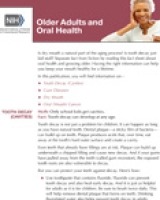Ask the Expert
NIDCR Deputy Director Jennifer Webster-Cyriaque, D.D.S., Ph.D. answers all your questions about flossing. Read the interview here.

An official website of the United States government
Here’s how you know
Official websites use .gov
A .gov website belongs to an official government organization in the United States.
Secure .gov websites use HTTPS
A lock () or https:// means you’ve safely connected to the .gov website. Share sensitive information only on official, secure websites.
Periodontal (gum) disease is an infection of the tissues that hold your teeth in place. It's typically caused by poor brushing and flossing habits that allow plaque—a sticky film of bacteria—to build up on the teeth and harden. It starts with swollen, red, and bleeding gums. If left untreated, it can spread to the bones surrounding the gums, making it painful to chew. In the worst cases, teeth may become loose or need to be removed.
NIDCR Deputy Director Jennifer Webster-Cyriaque, D.D.S., Ph.D. answers all your questions about flossing. Read the interview here.
Dental plaque that is not removed every day can harden and form tartar, and tartar build-up can lead to gum disease. Only a professional cleaning by a dentist or dental hygienist can remove tartar.
There are several risk factors for gum disease, but smoking is the most significant. Smoking also can make treatment for gum disease less successful. Other risk factors include hormonal changes in girls and women; certain illnesses, such as diabetes or AIDS and their medications; and genetics.
Back to topSymptoms of gum disease can affect various areas of the mouth.
| Affected Area | Symptoms |
|---|---|
| Gums | Gums may be red, swollen, tender, or bleeding. The gums may pull away from the teeth making them appear longer. |
| Teeth | Loose or sensitive teeth. Pain while chewing. |
| Other | Persistent bad breath. |
At a dental visit, a dentist or dental hygienist will perform tests to diagnose periodontal disease:
| Diagnostic Test | How it’s done | Why it’s done |
|---|---|---|
| Gum Examination | The dentist will examine your gums for signs of inflammation and use a tiny ruler called a “probe” to measure pockets around the teeth. | In a healthy mouth, the pockets around the teeth are usually between 1 and 3 millimeters. Deeper pockets can be a sign of periodontal disease. |
| Medical History Survey | The dentist will ask questions about your medical history. | Certain conditions or risk factors, like smoking or diabetes, can contribute to gum disease. |
| X-Ray | X-ray images of the teeth and mouth are taken. | An x-ray can show if there is any bone loss as a result of gum disease. |
Your dental professional may also refer you to a periodontist, a specialist in the diagnosis and treatment of gum disease, who may provide other treatment options not provided by your dentist.
Back to topThe main goal of treatment is to control the infection. The number and types of treatments will vary, depending on the extent of the gum disease. Any type of treatment requires that the patient keep up good daily care at home. The dentist may also suggest changing certain behaviors, such as quitting smoking, as a way to improve your treatment results.
Back to topYou can keep your gums and teeth healthy by:

Fact sheet on maintaining oral health for a lifetime.